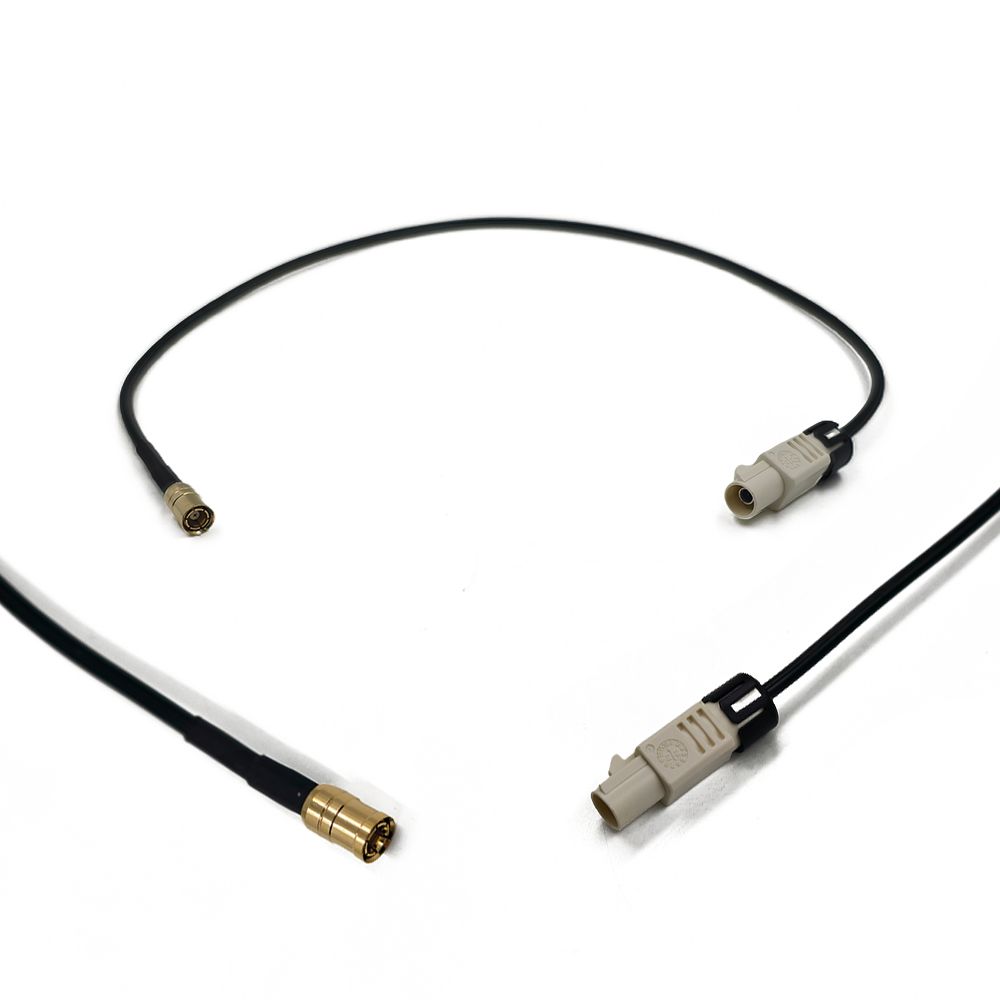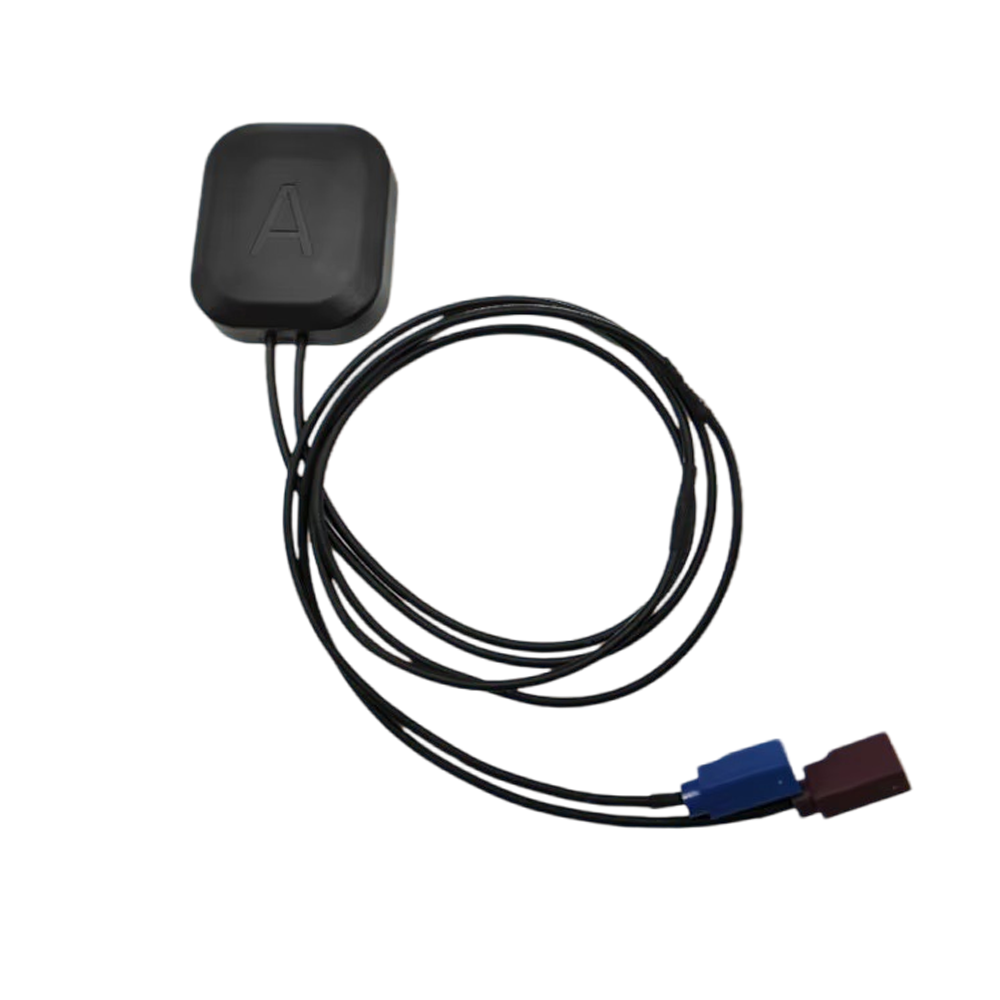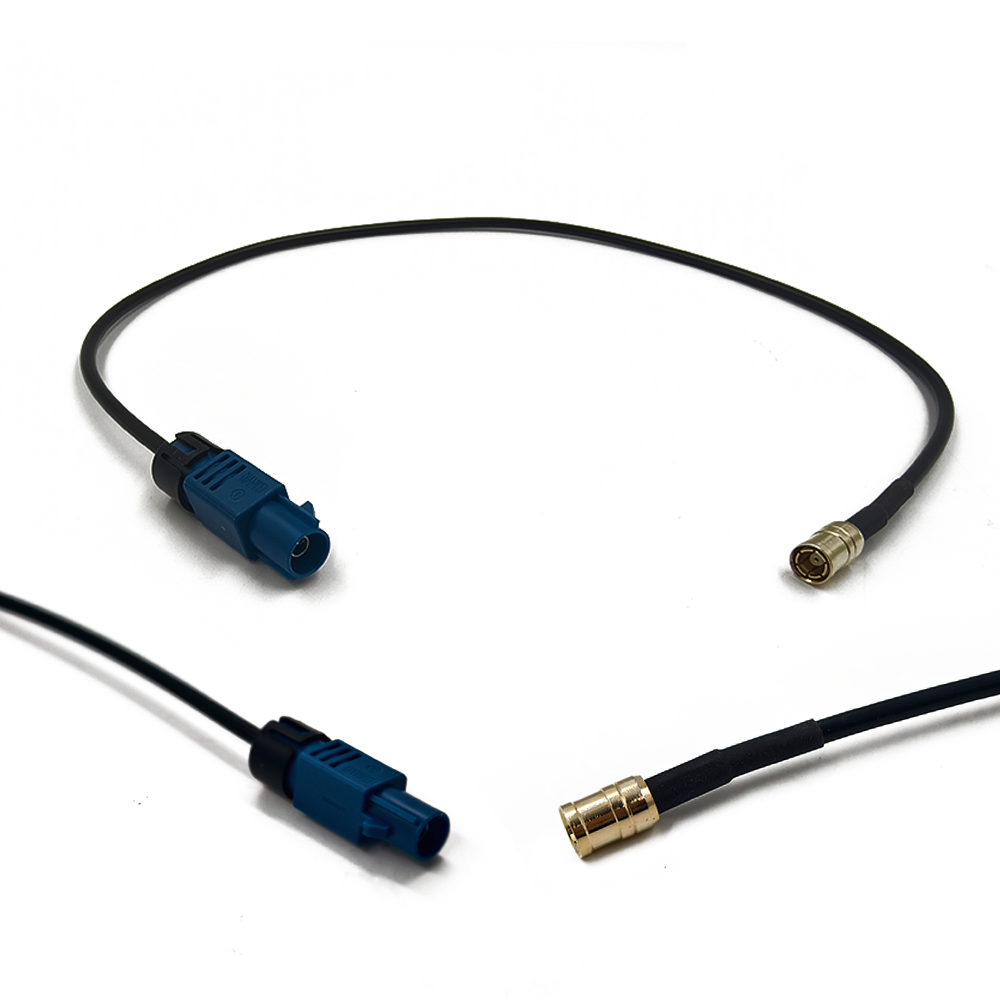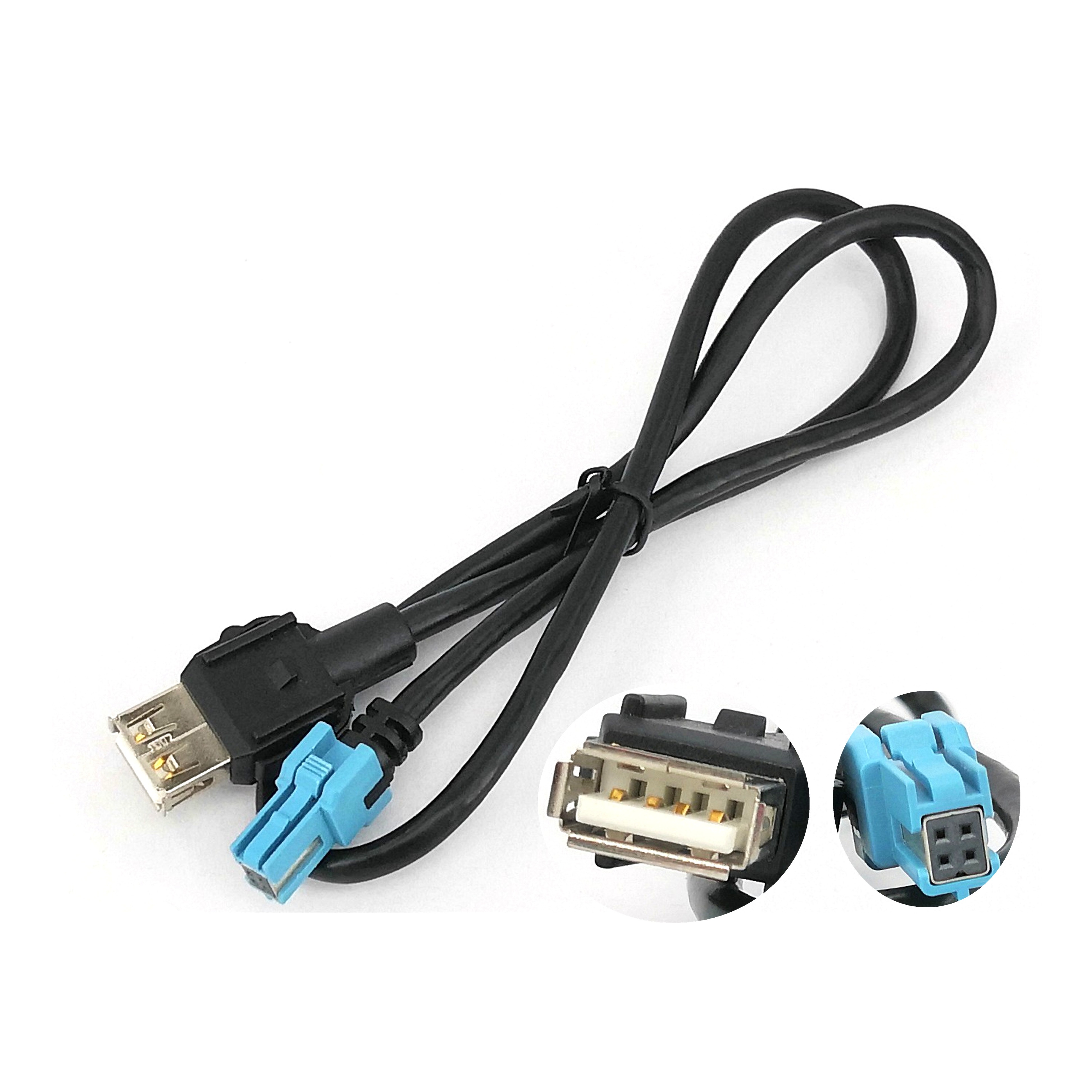Overview
The term "FAKRA" is an acronym derived from the German Fachkreis Automobil (Automobile Expert Group), a consortium of German car manufacturers and suppliers including Audi, BMW, Daimler, and others. This group standardized this connector family in the early 2000s to address the growing need for a reliable, high-frequency, and keyed interconnect system for automotive RF applications, such as GPS, cellular, and satellite radio. The FAKRA standard, formalized as ISO 20860-1, brought order to the chaos of proprietary connectors, ensuring interoperability and simplifying the supply chain.
A GNSS antenna is the front end of any positioning system. It is responsible for receiving extremely weak signals broadcast from satellites orbiting over 20,000 kilometers away. These signals, measured in decibels relative to a milliwatt (dBm), are incredibly faint by the time they reach the Earth's surface. Any loss, reflection, or interference introduced between the antenna and the receiver unit (typically located inside the vehicle or device) can severely degrade performance, leading to inaccurate positioning, slow time-to-first-fix (TTFF), or even a complete loss of signal.
This is where the FAKRA connector excels. It is fundamentally a miniaturized, standardized coaxial connector (typically based on a subminiature version B (SMB) interface) optimized for frequencies up to 6 GHz, comfortably encompassing all GNSS bands (e.g., GPS L1 at 1575.42 MHz, GLONASS L1, Galileo E1, BeiDou B1). Its primary role is to provide a consistent 50-ohm impedance match throughout the connection path, minimizing signal reflection and insertion loss to preserve the integrity of these precious satellite signals.
The "waterproof" variant adds a crucial layer of functionality. A standard FAKRA connector is designed for interior vehicle use. However, a GNSS antenna is almost always mounted externally—on the roof of a car, the deck of a boat, the fuselage of a drone, or the housing of a surveyor's pole—to ensure a clear, unobstructed view of the sky. This exposure subjects the antenna and its connection point to harsh environmental conditions: rain, snow, ice, dust, UV radiation, and high-pressure washdowns.
Moisture ingress is the nemesis of RF systems. Water within a connector can cause a catastrophic increase in signal attenuation (loss), effectively blocking the weak GNSS signals. Furthermore, it leads to corrosion of the metallic contacts, resulting in intermittent connections, increased intermodulation distortion (IMD), and ultimately, permanent failure. A waterproof FAKRA connector integrates sealing elements, most commonly a silicone rubber grommet or O-ring, into its design. When the connector is mated and the coupling mechanism is secured (usually by a push-and-click or screw-on style collar), this seal is compressed, creating a hermetic barrier that typically meets ingress protection ratings of IP67 (dust-tight and protected against immersion in water up to 1 meter for 30 minutes) or even IP69K (protected against close-range high-pressure, high-temperature spray downs).
In summary, the waterproof FAKRA connector is not merely a convenience; it is an engineered solution that ensures the continuous, reliable, and high-fidelity transmission of GNSS signals from the antenna element to the receiver, even in the most demanding environments. It represents a perfect synergy of RF engineering, materials science, and mechanical design, forming an indispensable link in the chain of modern navigation and telematics.
Design and Construction
The effectiveness of the waterproof FAKRA connector stems from its meticulous design, which elegantly balances electrical performance, mechanical robustness, and environmental sealing. Understanding its construction requires dissecting it into several key subsystems: the RF interface, the housing and keying mechanism, and the waterproofing seals.
1. The RF Interface (The Heart of the Signal Path):
At its core, a FAKRA connector is a coaxial interface. The central contact pin (male) and socket (female) are responsible for carrying the high-frequency signal. These are precision-machined or stamped and plated with a highly conductive and corrosion-resistant material, typically gold over nickel. The gold ensures excellent conductivity and low surface oxidation, while the nickel layer provides a robust diffusion barrier and enhances mechanical wear resistance. The dielectric material surrounding the center conductor is usually PTFE (Teflon) or similar fluoropolymers, chosen for their stable dielectric constant and low loss tangent across the target frequency range, which is critical for maintaining consistent 50-ohm impedance.
The outer shell provides the return path (ground) for the RF signal. The connector interface itself is based on the SMB standard, which offers a good compromise between size and performance for frequencies up to 4-6 GHz. The mating mechanism for the RF section is often a snap-on design, providing a secure and stable electrical connection.
2. The Outer Housing and Keying Mechanism (The Brain of Organization):
This is where the FAKRA standard truly distinguishes itself. The RF core is encapsulated within a larger, colored plastic housing. This housing serves multiple critical functions:
Polarization and Keying: The housing contains a unique mechanical key—a small plastic tab or groove in a specific location. This prevents mismating of different RF systems. For example, a blue connector with a key at a specific position is standardized for GNSS (GPS). You cannot physically plug a blue GNSS antenna into a green connector meant for a cellular module, or vice-versa. This prevents catastrophic damage and system malfunctions.
Color Coding: The housing color is a visual identifier of the application. As per FAKRA standards:
Blue: GPS/GNSS (the primary focus here)
Green: Cellular (e.g., GSM, LTE)
Yellow: Satellite Radio (e.g., SiriusXM)
Red: Bluetooth/Wi-Fi
And others for TV, SDARS, etc.
Secondary Locking Mechanism: The housing features a robust locking collar to ensure the connection remains secure in high-vibration environments like automobiles. The most common type is a push-and-click slider mechanism. The user pushes the connector onto its panel-mounted counterpart and slides a latch until it clicks audibly and tactilely into place. This provides vibration-proof security and a clear indication of a successful mate. Screw-on styles are also available for even more extreme environments.
3. The Waterproofing System (The Protective Shield):
The transition from a standard to a waterproof FAKRA connector is achieved through integrated sealing.
Primary Seal (Interface Seal): The most critical seal is located on the plug connector, surrounding the RF interface. It is typically a molded silicone rubber grommet or O-ring. When the locking collar is engaged, this seal is compressed against the flange of the jack connector, creating a watertight and dust-tight barrier at the point of connection.
Secondary Seals (Cable and Panel Seals): Waterproofing is useless if moisture can travel along the cable or through the mounting panel. Therefore:
Cable Gland: The rear of the connector where the coaxial cable enters features a compression gland. As the rear cap is tightened, it compresses a rubber seal around the cable jacket, preventing water from wicking along the cable.
Panel Seal: The jack connector, which is mounted to a bulkhead or vehicle panel, often has its own integrated rubber seal. This ensures that when it is tightened down with a nut, the mounting hole itself is sealed from the external environment.
Materials Selection:
The choice of materials is crucial for long-term performance. The plastic housing is typically made from high-quality, engineering-grade thermoplastics like PA66 (Nylon 66) or PBT. These materials offer an excellent balance of strength, rigidity, and resistance to temperature, UV radiation, and chemicals (like automotive fluids). The sealing elements are almost exclusively made from silicone rubber due to its exceptional flexibility across a wide temperature range (-55°C to +200°C), excellent resistance to weathering and ozone, and stable sealing properties.
The construction of a waterproof FAKRA connector is a testament to design-for-manufacture and design-for-reliability. Every component, from the gold-plated center pin to the colored housing and the silicone grommet, plays a specific and vital role in ensuring that the vital link between the GNSS antenna and the world remains intact, no matter the conditions.
Working Principles
The working principle of a waterproof FAKRA connector can be divided into two parallel functions: its primary role as an RF transmission line and its secondary role as an environmental barrier. Both must operate flawlessly for the system to succeed.
The RF Principle: Impedance Matching and Minimal Loss
The fundamental goal of any RF connector is to transmit electromagnetic waves from one point to another with maximum efficiency. This is achieved by maintaining a constant characteristic impedance throughout the entire signal path—the antenna element, the cable, the connector, and the receiver input. For most high-frequency applications, this impedance is 50 ohms.
Any discontinuity in this impedance causes a portion of the signal to be reflected back towards the source. This is known as a Voltage Standing Wave Ratio (VSWR) mismatch. High VSWR equates to signal loss and potential damage to sensitive transmitter circuits (though GNSS is receive-only, this is less of a concern). The design of the FAKRA's inner contact, dielectric, and outer shell is meticulously engineered to maintain this 50-ohm impedance through the connection point. The precise dimensions of the pin, the socket, and the air gaps between dielectrics are all calculated to minimize reflections.
The two key electrical performance metrics for a GNSS connector are:
Insertion Loss: This is the amount of signal power lost as it passes through the connector. It is desired to be as low as possible, typically well below 0.1 dB per connector mate at GNSS frequencies. Even a tiny loss is significant when dealing with signals that can be as weak as -130 dBm. The use of high-quality dielectrics and low-resistance plating (gold) keeps insertion loss to an absolute minimum.
Return Loss: This is a measure of how much signal is reflected back due to impedance mismatches. A high return loss value (e.g., 20 dB) is desirable, indicating that most of the signal is transmitted forward and very little is reflected back. The robust, stable mechanical connection of the mated FAKRA pair ensures consistent impedance and excellent return loss.
The push-and-click locking mechanism is critical here. It ensures a consistent and repeatable mating force every time. A loose connection would create an impedance discontinuity, increasing VSWR and return loss, and thus degrading the signal. The secure lock guarantees that the electrical characteristics are stable over time, even under vibration.
The Waterproofing Principle: Creating a Hermetic Barrier
The waterproofing function works on a straightforward mechanical principle: compression sealing.
Mating: The user aligns the plug connector with the jack, using the keying feature to ensure correct orientation.
Engagement: As the user pushes the connector forward, the RF contacts mate first. Subsequently, the silicone sealing grommet on the plug makes contact with the smooth, flat face of the jack's housing.
Locking and Sealing: The user then engages the locking mechanism (sliding the collar or screwing it on). This action pulls the plug connector forward with precise force, compressing the silicone grommet between the two connector bodies. Silicone is an elastomer; it deforms under this compression to fill any microscopic imperfections on the mating surfaces, creating a continuous, watertight seal. The compression is designed to be sufficient to block water under pressure but not so great as to make mating/unmating overly difficult or to permanently deform the seal.
The secondary seal at the cable gland works similarly. Tightening the rear cap compresses a rubber ferrule radially onto the cable jacket, forming a seal around the often irregular surface of the cable without damaging the inner conductors.
This combination of a pristine RF path and a robust environmental seal ensures that the incredibly faint whispers of satellite signals are gathered by the antenna and delivered to the receiver with the highest possible fidelity, enabling the complex digital signal processing algorithms to calculate a precise position, velocity, and time (PVT) solution.
Advantages and Challenges
-
The widespread adoption of the waterproof FAKRA connector for GNSS applications is driven by a compelling set of advantages, though designers must also be aware of its inherent limitations and challenges.
Advantages:
Standardization and Interoperability: This is its greatest strength. The FAKRA standard ensures that an antenna from manufacturer A will connect perfectly to a receiver from manufacturer B. This simplifies design-in for OEMs, expands options for integrators, and reduces costs through competition and economies of scale.
Excellent RF Performance: Designed specifically for multi-GHz automotive applications, it provides low VSWR, low insertion loss, and stable impedance matching up to 6 GHz, making it ideal for all current and future GNSS bands.
High Reliability and Durability: The robust plastic housing and secure locking mechanism are designed to withstand the vibration, shock, and temperature cycles of the automotive environment (-40°C to +85°C is standard, with higher grades available). The waterproof variants extend this reliability to harsh outdoor settings.
Error-Proofing: The color-coding and mechanical keying system drastically reduces the risk of assembly errors during vehicle manufacturing or aftermarket installation. This prevents costly rework and warranty claims.
Scalability: The FAKRA family includes connectors for a vast array of in-vehicle applications (GNSS, cellular, WiFi, radio), allowing designers to use a single, familiar connector system across multiple RF domains within one platform.
Challenges and Limitations:
Size and Form Factor: Compared to more minimalist coaxial connectors (e.g., MMCX), FAKKA connectors are relatively large and bulky. This can be a constraint in increasingly compact electronic modules and devices where board space is at a premium.
Cost: The complex housing, locking mechanism, and color-coding make a FAKRA connector significantly more expensive than a simple SMB connector. For high-volume, cost-sensitive consumer applications (e.g., a budget drone), this cost can be a deterrent.
Mating/Clearing Space: The push-and-click or screw-lock mechanism requires significant axial and radial space to mate and unmate. This must be carefully considered during the mechanical design phase of a device; a connector placed too close to another component or a wall may be impossible to service.
Potential for Improper Mating: While the keying system prevents cross-mating, it is still possible to force a connector on incorrectly if the key is damaged or if excessive force is applied, potentially destroying both the plug and jack. Proper training and careful handling are still required.
Evolution of Needs: As vehicles and devices move towards integrated "shark-fin" antenna modules that combine GNSS, cellular, and other services into a single unit, the need for multiple external FAKRA connections may diminish in favor of a single digital bus (like Ethernet) or a consolidated multi-port connector.
Despite these challenges, the advantages of performance, reliability, and standardization overwhelmingly justify the use of waterproof FAKRA connectors in most professional, automotive, and industrial GNSS applications where failure is not an option.
Applications and Future Trends
-
While born in the automotive industry, the waterproof FAKRA connector has found resonance wherever robust and reliable GNSS reception is required.
Applications:
Automotive Telematics: The original application. Used for in-car navigation systems, emergency call systems (eCall), vehicle tracking, toll collection, and advanced driver-assistance systems (ADAS) that require precise positioning.
Fleet Management and Logistics: Trackers on trucks, buses, and containers use rugged, waterproof FAKRA antennas to provide real-time location data across continents and in all weather conditions.
Marine and Aquatic Systems: On boats, yachts, and even autonomous underwater vehicles, waterproof GNSS antennas with corrosion-resistant connectors are essential for navigation and data logging.
Agriculture: Precision farming equipment—like automated tractors and harvesters—relies on centimeter-level accuracy from Real-Time Kinematic (RTK) GNSS systems. The antennas for these systems require flawless connectors to maintain signal integrity.
Surveying and Geomatics: High-precision GNSS base stations and rover antennas used in construction and land surveying demand the lowest possible signal loss, making a high-quality connector mandatory.
Aviation and Drones (UAVs): Drones use GNSS for navigation, stabilization, and autonomous flight planning. The antennas are exposed to high winds, rain, and wide temperature variations, necessitating a waterproof and secure connection.
Industrial IoT and Critical Infrastructure: Used for timing synchronization in cellular base stations, power grids, and financial networks, where GNSS provides a precise atomic clock reference.
Future Trends:
Integration with Advanced Antenna Technologies: The rise of Multi-Constellation, Multi-Frequency (MCMF) GNSS and High-Accuracy services is pushing antenna technology forward. Future FAKRA connectors will need to support even higher frequencies with lower loss to accommodate new bands like GPS L5 and Galileo E5/E6.
Miniaturization: Pressure to save space will drive the development of smaller form-factor FAKRA-inspired connectors that retain the keying and locking features but with a reduced footprint.
Hybrid Connectors: A significant trend is the move towards hybrid connectors that combine RF FAKRA contacts with power and data lines (e.g., USB, Ethernet, power pins) in a single, over-molded waterproof housing. This simplifies the connection to a complex antenna module that might contain GNSS, 5G, V2X, and WiFi all in one package, requiring only a single cable harness.
Material Advancements: The development of new, more durable plastics and sealing compounds will enhance performance in even more extreme temperatures and chemical environments, particularly for industrial and military applications.
Automated Assembly: As manufacturing automation increases, connector designs may evolve to be more amenable to robotic mating and installation, potentially featuring new latching mechanisms or guidance features.
The waterproof FAKRA connector is evolving from a standalone RF component into a potential core part of a more comprehensive connectivity solution for the next generation of smart, connected machines and vehicles.
Conclusion
In the grand narrative of technological advancement, connectors are rarely the heroes. Yet, as we have seen, the waterproof FAKRA connector for GNSS antennas is a component of profound importance. It is a masterpiece of pragmatic engineering, born from the collaborative need of a major industry to standardize and improve reliability.
It transcends its simple function of being an electromechanical bridge. It is a guardian of signal integrity, ensuring that the faint whispers from satellites billions of meters away are delivered without corruption. It is a fortress against the elements, protecting the sensitive RF pathway from the relentless assault of water, dust, and vibration. It is an organizer of complexity, using color and key to bring order and prevent error in increasingly crowded electronic systems.
From the family car navigating through a storm to the autonomous tractor plowing a field with centimeter precision, from the container ship crossing an ocean to the drone mapping a disaster zone, the reliable operation of the GNSS system hinges on the integrity of every link in its chain. The waterproof FAKRA connector, though small and often unseen, is one of the most critical and tested links in that chain.
As technology marches forward towards greater autonomy, connectivity, and precision, the demands on positioning systems will only intensify. The principles embodied by the FAKRA connector—standardization, performance, resilience, and quality—will remain paramount. Whether in its current form or in the evolved iterations of the future, this humble connector will continue to be an indispensable enabler, silently ensuring that we, and our machines, always know exactly where we are.




































































 Language
Language
 En
En Cn
Cn Korean
Korean

 Home >
Home > 








 18665803017 (Macro)
18665803017 (Macro)













